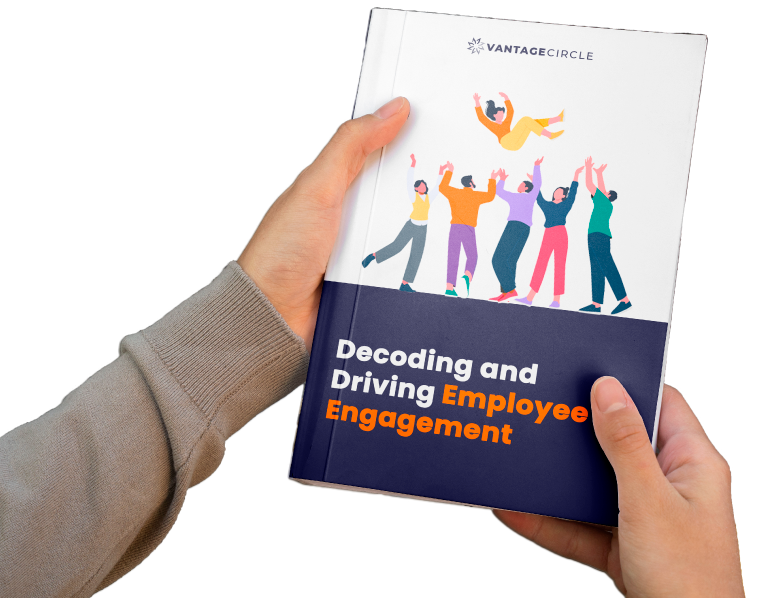Why Employee Recognition Boosts ROI—and Why It Matters to You

A Global Employee Recognition and Wellness Platform
People work for money but go the extra mile for recognition, praise, and rewards.
– Dale Carnegie, Leadership Training Guru
I’ve always wondered why, despite investing in various initiatives to boost morale and retention, organizations still face recurring challenges—high turnover, disengaged employees, and a significant performance gap. After much reflection, I realized the culprit: the lack of understanding of the true power of employee recognition.
At first, I was skeptical—how could something as simple as recognition really make a difference? But when I took a closer look, it all started to make sense. Recognition isn’t just about handing out praise; it’s about creating a culture where employees feel valued, leading to increased loyalty, enhanced productivity, and better overall performance. And once I recognized its impact, I saw the ROI firsthand, and it completely transformed how I approached leadership.
Here’s something that stood out to me: disengaged employees cost businesses globally a staggering $8.8 trillion in lost productivity, according to Gallup. That’s not just a statistic—it’s a wake-up call for organizations still overlooking the importance of recognition.
But how does this shift happen ? Let me walk you through it, but first, let’s understand the undeniable connection between recognition and its measurable ROI.
According to a survey, almost 78 percent of employees would work harder if they were better recognized.
It serves as the compass, guiding organizations in understanding the effectiveness and impact of their investment in employee appreciation.
Businesses can strategically align their recognition initiatives with overarching goals by quantifying the returns, ensuring a symbiotic relationship between employee morale and organizational success.
When people are financially invested, they want a return. When people are emotionally invested, they want to contribute.
–Simon Sinek
Key Takeaways
- Why Employee Recognition Programs Deliver High ROI
- Key Metrics to Calculate ROI on Employee Recognition
- The Multi-Dimensional Impact of Recognition Programs
- Tools and Strategies to Maximize ROI on Recognition
- Practical Steps to Implement and Measure Recognition ROI
Why Employee Recognition Programs Deliver High ROI

Employee Recognition programs aren't just feel-good initiatives but strategic business investments that yield tangible results. In my years of analyzing workplace dynamics have shown me that these programs are among the most effective drivers of business value. Let's explore why recognition delivers such impressive returns on investment.
ROI, or Return on Investment, helps evaluate the effectiveness of a recognition program in an organization.
Direct Business Impact
Social recognition has a proven ROI, and it only takes 1% of payroll investment to see the results
Strategic recognition delivers measurable financial benefits by slashing turnover and boosting productivity.
Here's something to consider: companies prioritizing strategic recognition see average turnover drop by 31%. With the cost of replacing an employee ranging from 50-200% of their annual salary, this simple yet powerful approach can save businesses significant resources.
Thus, the positive ROI of rewards and recognition is undeniable on whether it can contribute to real business success.
See the connection here!
Recognition programs go beyond just celebrating achievements—they create real impact where it matters. Strategic recognition delivers measurable financial benefits by slashing turnover and boosting productivity.
The ripple effect is undeniable as per this Gallup Report:
-
14% more productive
-
10% improvement in Customer Loyalty
-
23% jump in profitability
These numbers highlight a simple truth: when people feel appreciated, they go above and beyond.
The Engagement Connection
Employee engagement plays a crucial role in driving business success, and recognition programs are at the heart of fostering it. By creating emotional connections between employees and their mission, recognition programs transform workplaces.
A survey by Worldatwork found that 85% of companies with recognition programs saw a positive impact on employee engagement.
According to a SHRM study, a majority of human resource professionals state that their employee recognition program positively impacts:
-
organizational culture (85%)
-
employee engagement (84%)
-
employee experience (89%)
-
employee relationships (86%)
-
organizational values (83%)
When employees feel valued and connected, their contributions elevate the entire organization.
Cultural Transformation
The most profound impact of recognition programs is their ability to transform company culture. We've seen firsthand how recognition drives meaningful cultural shifts when ingrained in daily work life. Recognition fosters an environment where innovation thrives, collaboration flourishes, and employees feel genuinely appreciated.
Key Metrics to Calculate ROI on Employee Recognition
Measuring the ROI of recognition programs requires tracking both quantitative and qualitative metrics. These metrics provide insights into program effectiveness and identify areas for improvement
Have you ever noticed a subtle shift in your team's vibe—where productivity drops or engagement declines without a clear explanation? These shifts can often be traced back to a lack of recognition. Thus, it's crucial to understand how employee recognition directly impacts key metrics like absenteeism, turnover costs, and disengagement-related losses.
Why These Metrics Matter:
Absenteeism Rate:
When employees don't feel valued, absenteeism is predictable. Recognition is a powerful motivator to show up, both physically and emotionally. Tracking absenteeism helps reveal if employees feel disconnected, leading to decreased work attendance.
Turnover Cost:
Losing a valuable employee can cost an organization 30% to 50% of the employee's salary, with more specialized roles in sectors like healthcare reaching up to 200%
When recognition efforts are absent, turnover rates tend to rise. Companies can gauge the cost of neglecting employee appreciation by measuring turnover alongside recognition initiatives.
Disengagement-Related Losses:
Employee engagement is a key predictor of overall productivity and job satisfaction. Disengagement, on the other hand, can directly affect an organization's bottom line. According to a study disengaged employees cost organizations $450 billion annually. By tracking engagement alongside recognition initiatives, businesses can identify trends that lead to disengagement, allowing them to act before productivity suffers.
Additional Metrics to Track:
Employee Net Promoter Score (eNPS): A strong eNPS reflects a positive workplace driven by effective recognition.
Collaboration Rates: Recognition fosters trust, boosting teamwork and cross-functional cooperation.
Innovation Metrics: Recognizing creative contributions encourages employees to generate new ideas and improvements. According to Globoforce, 78 percent of employees would work harder if they were better recognized.
According to McKinsey, up to 55 percent of employee engagement is driven by nonfinancial recognition.
The Multi-Dimensional Impact of Recognition Programs

Enhancing Employee Experience Through Recognition
We've seen how recognition programs can shape an employee's daily experience at work. When recognition is frequent and heartfelt, it transforms ordinary moments into something special. A quick "thank you" or a public shout-out can boost an employee's day, making them feel appreciated and seen. This, in turn, significantly impacts their overall engagement and job satisfaction.
A study reveals that 85% of professionals want to hear "thank you" in day-to-day interactions. This highlights the importance of verbal acknowledgment and appreciation in the workplace.
When recognition is consistent, employees are more likely to be invested in their work and motivated to give their best. Companies see a strong correlation between the frequency of recognition and the engagement scores.
Equity in recognition is another key piece. When recognition is equally distributed, it helps to build trust. Regardless of their role or tenure, every employee deserves to feel valued. We've found that when recognition is fair and inclusive, it fosters a sense of belonging, which is critical for a healthy work culture. Everyone wants to feel like they matter.
Recognition positively impacts mental health and well-being. When employees are consistently acknowledged for their hard work, it uplifts their spirits and helps reduce stress.
Case Study: At Vantage Circle, we have implemented a peer-driven recognition model. Employees can give each other recognition points for teamwork, problem-solving, and innovation. The results have been outstanding. The culture becoming more collaborative, employees felt empowered, and job satisfaction levels soared.
While recognition transforms individual experiences, its influence can redefine company culture as a whole.
How Recognition Shapes Organizational Culture
In my opinion, recognition is the backbone of a strong company culture. It connects to key cultural pillars like purpose, appreciation, and leadership. Employees who are recognized for their efforts feel more aligned with the company's mission and values. This sense of purpose is contagious and spreads across teams, strengthening the culture.
Pulse surveys can give real insights into how recognition affects cultural health. These surveys provide quantitative data that shows a clear link between recognition and employee engagement. It's always been eye-opening to see how this data reflects individual morale and the health of the entire company culture.
Recognition also plays a massive role in cross-functional collaboration. When teams recognize one another across departments, it always leads to a more inclusive, innovative environment.
For remote and hybrid teams, recognition is crucial. For instance, working with a client with a dispersed workforce, we focused on incorporating virtual recognition into their culture. It helped maintain a sense of community and ensured no one felt isolated or overlooked.
Recommended Resource: 12 Amazing Virtual Employee Recognition Ideas.
Impact on Business: Why Recognition is More Than a Feel-Good Initiative
Investing in employee recognition is investing in business success. Recognize effort, and you’ll reap the rewards in engagement, loyalty, and bottom-line growth.
When we think of recognition programs, it's easy to imagine them as something designed to make employees smile. But the truth is recognition goes far beyond boosting morale—it delivers tangible, measurable results that impact every aspect of a business. Over the years, I've worked with companies that transformed their workplaces by prioritizing recognition. Here's what I've learned about the ripple effect of saying "thank you."
Employee recognition drives measurable business results.
Increases Revenue per Employee: Recognized employees stay engaged, work efficiently, and deliver higher performance. Engaged teams boost revenue by up to 21%.
Improves Productivity: When you acknowledge employees, they stay motivated, collaborate better, and innovate faster, driving overall productivity.
Reduces Absenteeism: Recognition reduces unnecessary absences. Valued employees show up consistently, keeping operations smooth and reliable.
Strengthens Retention: Acknowledging contributions builds loyalty. Companies with recognition programs cut voluntary turnover considerably, saving recruitment and onboarding costs. A combined report from Globoforce and SHRM revealed that 68% of employers who run a value-based employee recognition program saw an improvement in employee retention.
Maximizes ROI: Recognition saves money and boosts profits by improving retention, reducing absenteeism, and increasing output.
Happier Employees, Happier Customers: Recognized employees are more positive and engaged, which directly enhances customer satisfaction. Recognition is directly proportional to happiness, according to a study from Warwick University , happier employees are around 12% more productive.
The ripple effect of recognition extends to customers. Employees who feel appreciated bring that positivity to their interactions, creating better customer experiences.This connection between engaged employees and satisfied customers enhances brand perception and builds long-term loyalty.
So,when organizations prioritize recognition, they unlock a cycle of engagement, performance, and customer satisfaction that fuels success.
Financial ROI Compared to Other HR Initiatives
Recognition programs consistently yield higher ROI than other HR initiatives. Unlike training or wellness programs with significant upfront costs and delayed outcomes, recognition provides immediate, measurable benefits.
An SHRM study states that a recognition and rewards program is more than 2X likely to drive better business goals.
It reduces turnover saving on recruitment and training. Recognized employees are more productive, directly boosting revenue. Recognition also improves operational efficiency by reducing absenteeism and promoting collaboration.
For every dollar spent on recognition, organizations see faster, more visible returns compared to training or wellness programs. Recognition taps into intrinsic motivation, delivering quick improvements in engagement, performance, and customer satisfaction.
Recognition is a strategic investment with proven financial and operational returns, consistently outperforming other HR initiatives while fostering a culture of trust and excellence.
Tools and Strategies to Maximize ROI on Recognition
To get the most from your recognition programs, you need the right tools and strategies that make recognition a natural part of your workplace. Here’s how to boost its impact and ROI:
-
Embed Recognition into Daily Workflows: Make recognition an everyday habit. Use platforms like Vantage Pulse or Kudos to help managers and peers recognize contributions in real time, keeping it spontaneous and integrated into daily tasks.
-
Use Technology to Scale: Expand recognition across your organization with scalable tools. Automated systems can instantly deliver personalized messages, rewards, or points, ensuring every employee feels valued, no matter where they work or how large the team.
-
Get Leadership on Board: Leadership commitment is key. When senior leaders actively participate in recognition, set an example, and communicate its importance, recognition becomes part of the culture, not just a program.
-
Set a Recognition Budget: Dedicate funds specifically for recognition. Whether it's small tokens, experiences, or gift cards, a budget ensures you consistently show appreciation and keep employees motivated.
-
Encourage Peer-to-Peer Recognition: Empower employees to recognize one another. Peer-to-peer recognition builds a stronger sense of community, reinforces positive behavior, and creates a culture where appreciation flows in all directions.
-
Create a Continuous Feedback Loop: Regularly gather employee feedback on your recognition programs. This helps fine-tune the program, ensuring it stays relevant, impactful, and aligned with company goals.
By embedding recognition into everyday workflows, leveraging scalable tools, and gaining leadership support, you can maximize the ROI of your recognition programs and create a more engaged, motivated, and high-performing workforce.
Personalizing Recognition with AI and Automation
By using AI and automation to personalize recognition, avoiding common pitfalls, and leveraging innovative platforms organizations can create meaningful, scalable recognition programs that drive results.
These technologies allow companies to:
Tailor Recognition: AI-powered platforms can analyze employee performance, preferences, and behaviors to deliver personalized recognition. For example, an AI system can suggest the best times for recognition or highlight specific achievements, ensuring that employees feel truly seen and valued.
Streamline Processes: Automation ensures that no one is overlooked. AI tools can automatically track milestones like work anniversaries, project completions, or birthdays and trigger recognition messages without manual intervention, ensuring timely and consistent appreciation.
Enhance Engagement: Personalized recognition drives higher employee engagement. AI can offer real-time suggestions for how peers can recognize each other, creating a continuous loop of appreciation and motivation.
Avoiding Common Pitfalls in Recognition Programs
To avoid the common mistakes that can undermine recognition efforts, focus on these key strategies:
Be Consistent: Ensure that recognition is integrated into the day-to-day culture and is not reserved for annual reviews or special occasions.
Avoid Generic Recognition: Ensure recognition is specific, timely, and relevant to the employee’s contributions to make it more impactful.
Balance Peer and Manager Recognition: Encourage peer-to-peer recognition, allowing employees at all levels to appreciate one another, creating a more inclusive, supportive environment.
Don’t Overlook Remote Employees: Recognition programs should be inclusive, making sure remote employees are equally acknowledged. Use digital platforms that allow everyone, regardless of location, to be recognized and appreciated.
Innovative Tools and Platforms
Employee and people engagement platforms like Vantage Circle, Bonusly,and Achievers utilize tools for targeted messaging and ensure leadership actively communicates organizational goals.
For instance,Bonusly; A platform that enables peer-to-peer recognition with a rewards system. Employees earn points for their contributions, which can be redeemed for rewards. Bonusly enhances engagement by creating a culture of continuous, personalized recognition.
Another comprehensive platform is Vantage Circle; that offers features like automated recognition, rewards, and surveys. Vantage Circle allows for personalized, timely recognition across various channels, providing employees with a tailored experience while driving engagement.
Platforms that have demonstrated proven ROI by increasing employee retention, boosting productivity, and improving overall engagement, make for an excellent investmentsfor organizations looking to scale and personalize their recognition programs.
Recommended Resource: To get started, Listen to this podcast about designing a winning employee recognition strategy by Matt Burns
Practical Steps to Implement and Measure Recognition ROI
Here's how to take a structured approach to implement and measure recognition ROI, ensuring it becomes a cornerstone of your organization's success.
- Start with Clear Goals and Metrics
Every successful strategy begins with clarity. Ask yourself: What are we trying to achieve with recognition? Is it to boost engagement, reduce turnover, or enhance team productivity?
Once your goals are defined, tie them to specific metrics:
-
Engagement Scores: Use tools like pulse surveys to monitor changes over time.
-
Retention Rates: Assess whether recognition reduces voluntary exits.
-
Productivity Levels: Track improvements in performance and collaboration.
For example, organizations can easily collect real-time feedback using platforms like Vantage Pulse, allowing them to understand the current state of employee engagement before launching their program.
- Build Your Baseline
Before you begin, establish a starting point. Gather data on key metrics like turnover rates, employee satisfaction scores, and productivity levels.
Don't stop at numbers—talk to your employees. What do they think of the existing recognition practices? Anonymous surveys or focus groups can reveal pain points and areas ripe for improvement, giving your strategy a solid foundation.
- Track, Tweak, and Transform
Recognition programs aren't a one-and-done effort. They need continuous monitoring and refinement to stay effective.
Leverage dashboards, like those offered by Vantage Recognition, to track recognition activity. Are leaders actively participating? Are employees engaging with the program? Visualizing trends allows you to identify what's working and where adjustments are needed.
For instance, if specific teams are less engaged, consider tailoring the program to their particular needs, whether introducing new reward options or increasing peer-to-peer recognition opportunities.
- Make It Personal: The Power of Storytelling
Data is robust, but stories bring it to life. Employees who feel genuinely seen and valued are often eager to share how recognition has impacted them.
Capture these moments. For example:
A peer-to-peer shout-out leads to stronger team bonds.
A long-overlooked employee finally feels appreciated and motivated. Employee recognition programs can be a crucial component for creating a motivating workplace culture. Employees thrive on positive reinforcement, and such programs put an additional spotlight on the effort people put into their jobs.
These stories don't just validate your program's success—they inspire others to participate. Sharing them through newsletters, all-hands meetings, or company intranets can amplify the emotional impact of recognition.
- Showcase the ROI
The final piece is communicating the results—both qualitative and quantitative. Show how recognition has made a difference. Highlight improvements like:
-
Increased employee satisfaction and engagement scores.
-
Reduction in turnover rates, translating to cost savings.
-
Boosts in team productivity and collaboration.
A survey by Worldatwork found that 85% of companies with recognition programs saw a positive impact on employee engagement.
Real-Life Examples of Recognition ROI Success
To build credibility and demonstrate the tangible benefits of recognition programs, let’s explore some success stories that highlight measurable ROI outcomes across industries. These case studies showcase the power of recognition in driving employee engagement, reducing turnover, and improving performance.
What makes recognition stand out is how quickly and effectively it pays off. Unlike training programs that take months or wellness benefits that are harder to quantify, recognition creates an immediate impact.
Investing in recognition programs offers a substantial return on investment. For instance,Wipro experienced an increase in appreciation by 62.53% in 2022-23 after implementing Vantage Circle's platform.
This surge in recognition likely contributed to enhanced employee engagement and productivity, providing a significant ROI compared to other HR initiatives.
Industry-Specific Outcomes
Healthcare
In healthcare, for instance, recognition programs have been a game-changer. In the pharmaceutical sector, Sun Pharma increased its employee engagement levels with the help of Vantage Circle through exclusive deals and discount packages.
In the healthcare industry, recognition and rewards programs mostly revolve around patient care and satisfaction, reduce turnover rates, and increase employee productivity.
According to a Hay Group Study, it was noticed that companies with engaged employees had the power to generate 89% greater patient satisfaction and 50% higher patient loyalty as compared to their disengaged peers
Technology
In the technology industry, recognition program can help to attract and retain top talent, boost employee morale, and increase innovation.
A joint study by Gallup and Workhuman found that with the right recognition practices with employees, 56 percent are less likely to be looking for external job opportunities; 73 percent are less likely to feel burned out on the job and are five times more likely to see a path to grow at their organizations.
Retail
In the retail industry, recognition programs can help to improve customer service, increase sales, and reduce employee turnover rates.
Research has shown that organizations with highly engaged employees enjoy 26% higher revenue per employee, as well as 13% greater total returns to shareholders.
Financial Services
Financial services industry is known to have the the highest number rewards and recognition programs as compared to others. Recognition plays a key role improving customer satisfaction, increase sales, and reduce employee turnover rates.
As per the Gallup Workhuman research - 56% Employees who work in the finance and insurance industry are likely to have a recognition program as compared to others.
By tailoring recognition strategies to specific demographics and challenges, companies can improve retention, boost productivity, and foster a culture of engagement.
Conclusion : The Recognition Ripple Effect
To summarize, Recognition isn't just about creating happier employees—it's about building a workplace where people thrive, collaborate, and innovate. When implemented strategically, it drives organizational success with clear, measurable ROI.
By setting clear goals, tracking progress, and leveraging employee recognition platforms, you can turn recognition into more than just a gesture—it becomes a transformative strategy that reshapes your workplace for the better.
So, are you ready to harness the full power of recognition? The results might just surprise you.

















